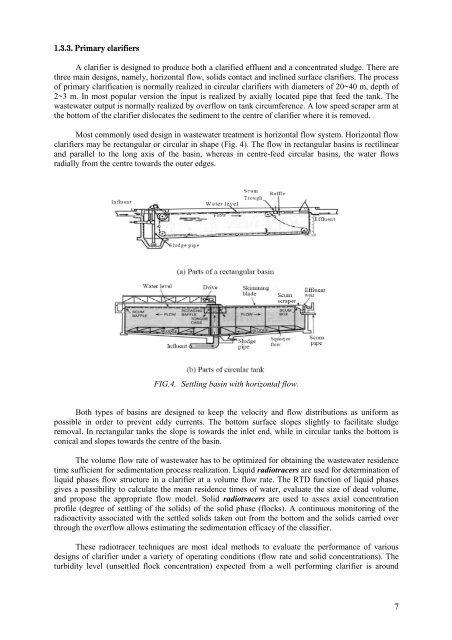Download file - Ayuntamiento de Zaragoza
Download file - Ayuntamiento de Zaragoza
Download file - Ayuntamiento de Zaragoza
Create successful ePaper yourself
Turn your PDF publications into a flip-book with our unique Google optimized e-Paper software.
1.3.3. Primary clarifiersA clarifier is <strong>de</strong>signed to produce both a clarified effluent and a concentrated sludge. There arethree main <strong>de</strong>signs, namely, horizontal flow, solids contact and inclined surface clarifiers. The processof primary clarification is normally realized in circular clarifiers with diameters of 20~40 m, <strong>de</strong>pth of2~3 m. In most popular version the input is realized by axially located pipe that feed the tank. Thewastewater output is normally realized by overflow on tank circumference. A low speed scraper arm atthe bottom of the clarifier dislocates the sediment to the centre of clarifier where it is removed.Most commonly used <strong>de</strong>sign in wastewater treatment is horizontal flow system. Horizontal flowclarifiers may be rectangular or circular in shape (Fig. 4). The flow in rectangular basins is rectilinearand parallel to the long axis of the basin, whereas in centre-feed circular basins, the water flowsradially from the centre towards the outer edges.FIG.4. Settling basin with horizontal flow.Both types of basins are <strong>de</strong>signed to keep the velocity and flow distributions as uniform aspossible in or<strong>de</strong>r to prevent eddy currents. The bottom surface slopes slightly to facilitate sludgeremoval. In rectangular tanks the slope is towards the inlet end, while in circular tanks the bottom isconical and slopes towards the centre of the basin.The volume flow rate of wastewater has to be optimized for obtaining the wastewater resi<strong>de</strong>ncetime sufficient for sedimentation process realization. Liquid radiotracers are used for <strong>de</strong>termination ofliquid phases flow structure in a clarifier at a volume flow rate. The RTD function of liquid phasesgives a possibility to calculate the mean resi<strong>de</strong>nce times of water, evaluate the size of <strong>de</strong>ad volume,and propose the appropriate flow mo<strong>de</strong>l. Solid radiotracers are used to asses axial concentrationpro<strong>file</strong> (<strong>de</strong>gree of settling of the solids) of the solid phase (flocks). A continuous monitoring of theradioactivity associated with the settled solids taken out from the bottom and the solids carried overthrough the overflow allows estimating the sedimentation efficacy of the classifier.These radiotracer techniques are most i<strong>de</strong>al methods to evaluate the performance of various<strong>de</strong>signs of clarifier un<strong>de</strong>r a variety of operating conditions (flow rate and solid concentrations). Theturbidity level (unsettled flock concentration) expected from a well performing clarifier is around7
















